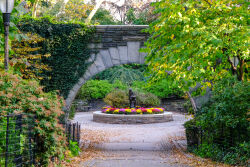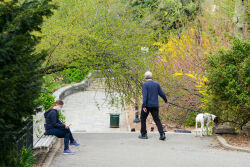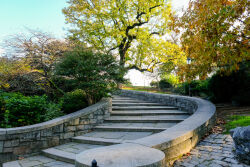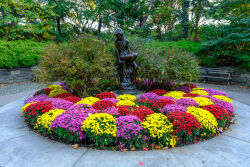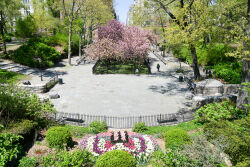Carl Schurz Park
Catbird Playground
The fanciful inlaid granite illustration of a seated cat adorned with wings alludes to the playground’s name, “Catbird.” The name is also a veiled reference to the “catbird seat”, an expression meaning an advantageous position that was first documented in James Thurber’s 1942 short story, which is appropriate considering the power held by residents of nearby Gracie Mansion. The former residence of Parks Commissioner Robert Moses, who helped create this playground, is located just steps from the park at 2 Gracie Square.
Originally designed in 1935 by Gilmore D. Clarke, Catbird Playground occupies the semi-circular space at the north end of the park’s rectangular plaza. This area was originally used as a separate seating area and flower garden. In 1965, play equipment was introduced and steps were added to connect it to the playground. In 2000, Parks replaced old timber play equipment with a new steel unit that meets current safety and accessibility standards.The playground features an ensemble of high platforms, challenging climbers, slides, and overhead ladders and rings. Another series of play activities is accessible from ground level below the decks.
The renovation included new benches, trees, and pavement, as well as three granite paving panels based on artwork by artist Carol Zaloom that earned the playground its name. The panel depicting the whimsical seated Catbird is based on one of Zaloom’s woodcuts. The two additional panels depict Gracie Mansion and Thompson's Battery, a Revolutionary War fort that occupied what is now Carl Schurz Park. Zaloom’s illustrations are also incorporated into the steel gates on the west side of the playground, representing the New York City landscape, past and present. The words “The Catbird Seat” can be found etched into a bench at the northern end of the playground.
The catbird is a songbird indigenous to North and South America and belongs to the mockingbird family. The gray catbird grows to about nine inches long, and is characterized by slate gray feathers, a black-feathered crown, and chestnut-colored area underneath the tail. The bird’s name refers to the call it makes, which can sound similar to the “meow” of a cat. It usually sits on a high perch overlooking the world below, hence the derivation of the expression “catbird seat.”
Check out your park's Vital Signs
Clean & Safe
Green & Resilient
Empowered & Engaged Users
Share your feedback or learn more about how this park is part of a
Vital Park System

